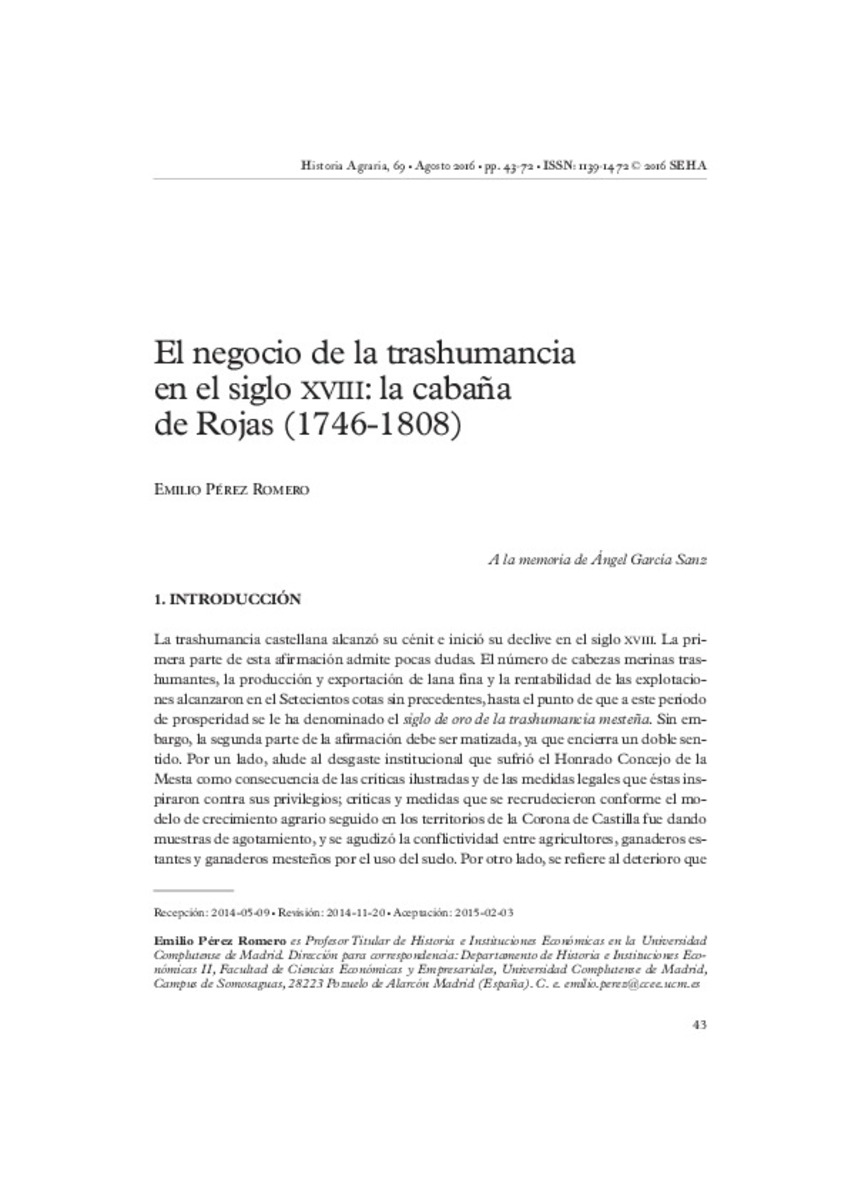Mostrar el registro sencillo del ítem
El negocio de la trashumancia en el siglo XVIII: la cabaña de Rojas (1746-1808)
| dc.contributor.author | Pérez-Romero, Emilio | |
| dc.date.accessioned | 2017-03-10T13:39:13Z | |
| dc.date.available | 2017-03-10T13:39:13Z | |
| dc.date.issued | 2016-08 | |
| dc.identifier.issn | 1139-1472 | |
| dc.identifier.uri | http://hdl.handle.net/10234/166627 | |
| dc.description.abstract | This article attempts to clarify how sheep and goat transhumance developed within the Crown of Castile during the second half of the eighteenth century. It analyses the case of the Rojas herd from the accounting and administrative documentation preserved in the Count of Bornos Archive (Nobility Section of the National Historical Archive). The study establishes that although the evolution of prices adversely affected overall income from sheep and goat commerce, it continued to be profitable until the War of Independence. Nevertheless, in order to maintain the total volume of revenue, the decrease in the profit per unit had to be compensated with an increase in the number of heads of cattle, which required access to new pastures. As a result, the social position of the herd owners grew in importance. Moreover, it seems that over the course of this period there was a significant redistribution of the income generated by transhumance, which benefitted large-scale ranchers at the expense of the smaller-scale operations and shepherds. | ca_CA |
| dc.description.abstract | Este artículo intenta esclarecer la trayectoria de la ganadería lanar trashumante en la Corona de Castilla durante la segunda mitad del siglo XVIII. Para ello, se analiza el caso de la cabaña de Rojas a partir de la documentación contable y administrativa que de ella se conserva en el archivo del conde de Bornos (Sección Nobleza del Archivo Histórico Nacional). El estudio muestra que, aunque la evolución de los precios relativos afectó negativamente a sus cuentas de resultados, la explotación continuó siendo rentable hasta la guerra de la Independencia. No obstante, para mantener el volumen total de ingresos, tuvo que compensar la caída del beneficio unitario con un aumento del número de ovejas, lo cual requirió el acceso a nuevos pastos. A este respecto, la posición social de los propietarios de la cabaña adquirió una creciente importancia. Por otro lado, todo apunta a que en el transcurso del período estudiado se produjo una significativa redistribución de la renta generada por la trashumancia en beneficio de los grandes ganaderos, a costa de los de menor cuantía y, también, de los pastores. | ca_CA |
| dc.format.extent | 30 p. | ca_CA |
| dc.format.mimetype | application/pdf | ca_CA |
| dc.language.iso | spa | ca_CA |
| dc.publisher | Sociedad Española de Historia Agraria (SEHA) | ca_CA |
| dc.relation.isPartOf | Historia agraria: Revista de agricultura e historia rural, nº 69, 43-72 | ca_CA |
| dc.rights | © 2016 SEHA | ca_CA |
| dc.rights.uri | http://rightsstatements.org/vocab/InC/1.0/ | * |
| dc.subject | Desamortización | ca_CA |
| dc.subject | Elites locales | ca_CA |
| dc.subject | Bienes comunales | ca_CA |
| dc.subject | España interior | ca_CA |
| dc.subject | Desintailement | ca_CA |
| dc.subject | Local elites | ca_CA |
| dc.subject | Commons | ca_CA |
| dc.subject | Interior of Spain | ca_CA |
| dc.title | El negocio de la trashumancia en el siglo XVIII: la cabaña de Rojas (1746-1808) | ca_CA |
| dc.type | info:eu-repo/semantics/article | ca_CA |
| dc.subject.jel | N53 | ca_CA |
| dc.subject.jel | P26 | ca_CA |
| dc.subject.jel | Q15 | ca_CA |
| dc.subject.jel | Q18 | ca_CA |
| dc.rights.accessRights | info:eu-repo/semantics/openAccess | ca_CA |
| dc.relation.publisherVersion | http://repositori.uji.es/xmlui/handle/10234/166611 | ca_CA |







